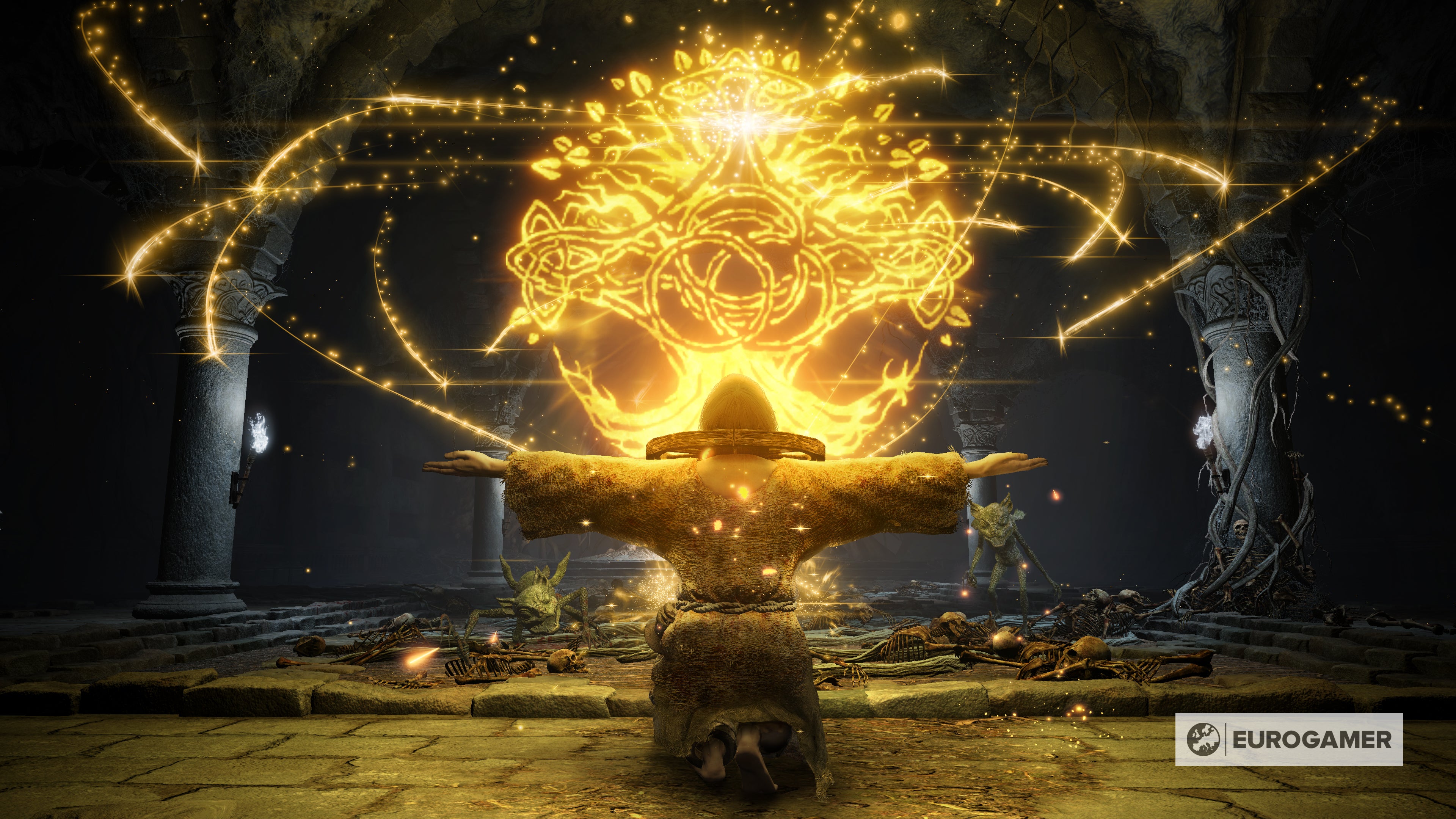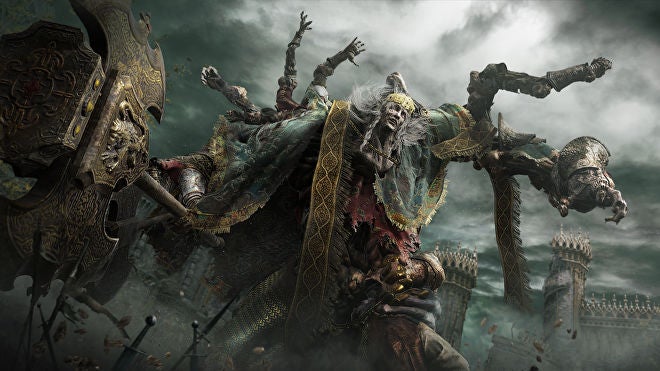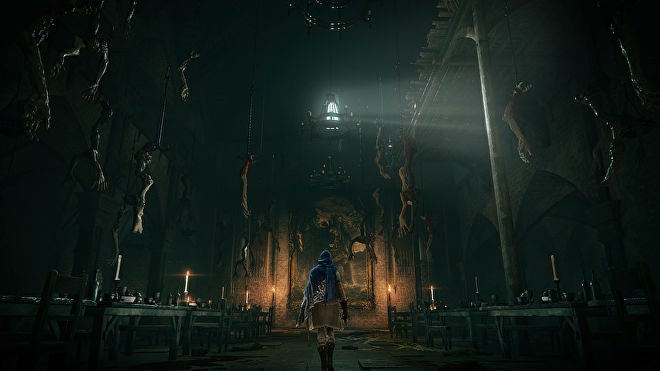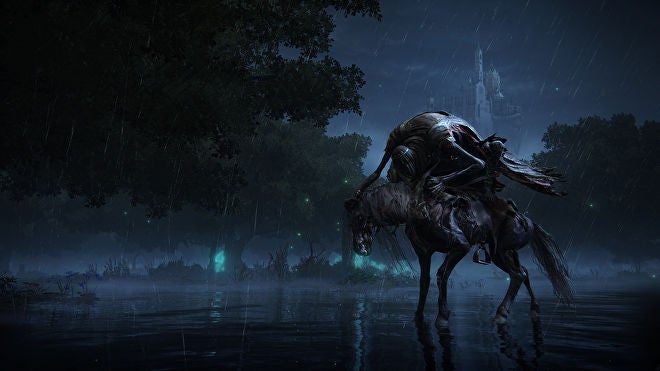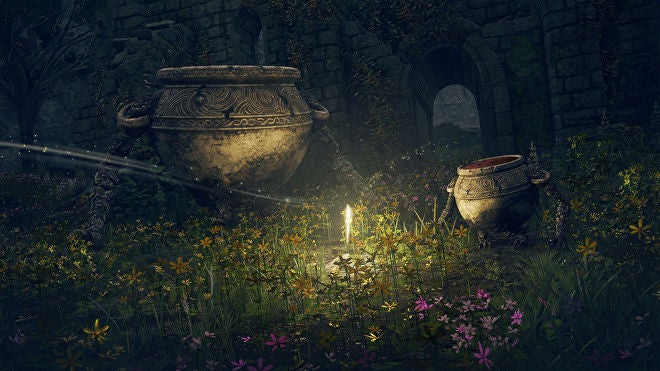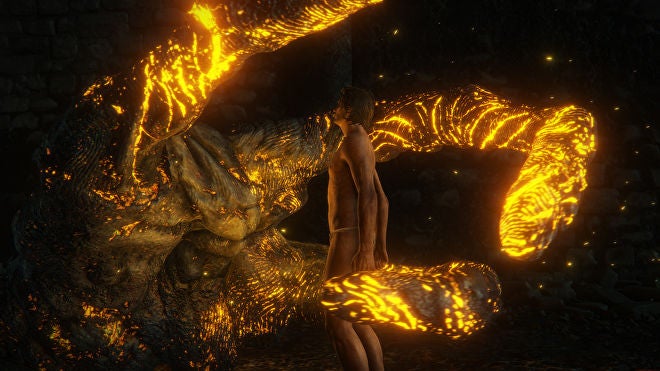In typical From fashion, Elden Ring’s story is fragmented; the studio hasn’t changed its basic principle of providing players with an ambiguous narrative and a world they can choose to interpret for themselves. But it also feels like From was hinting that Elden Ring’s story would be perhaps more character-based than From’s previous titles, where most of the lore is gleaned offscreen from fragments and relics found after the fact, rather than seeing it played out in front of you. “We’re often told that our games have stories that are difficult to understand, but this time we feel that, rather than focusing on just the world itself, the characters and the drama surrounding them will paint a clearer picture of the mainline story and help players become more immersed in the story than ever before,” Kitao told us. That’s not to say that the structure and setting of the world doesn’t have a huge role to play still. One thing From was very keen to impress was that Elden Ring centres around a vast and interconnected Overworld, and one that’s not just big for the sake of being big. Branching out from this open area are numerous dungeons which are seamlessly connected within the Overworld, containing treasures and fearsome bosses. “The Land Between is truly dense with dangers and secrets,” Kitao says, “and our aim is for the player to make these discoveries and have these chance encounters just through the act of exploring.” It sounds like these dungeons feature smaller scale bosses and treasure, but also branching out from the open Overworld are much larger multi-tiered castles and other huge dungeon areas, which are perhaps more akin to what you find in the Dark Souls series. These colossal structures, once you dive in, will slowly unfold with more intricate, multi-layered level design, granting players larger and perhaps more thematic or unique challenges to overcome. From are calling these Legacy Dungeons, and it feels like these will be the areas to approach when you want to maybe further the main quest or test your might against a bigger challenge, once you’ve cut your teeth on a few smaller dungeons first. Calling them dungeons feels a little bit simplistic though, because it makes them all sound like the same subterranean crypts we’ve seen before in a host of other games. But that isn’t the case, From says; both Legacy Dungeons and the Overworld itself encompass a huge variety of environments and biomes, each with their own unique characteristics and dangers to face. We were told there were wintery plains and snow-capped peaks, a flooded city, and a whole other range of diverse maps, each with their own distinct flavour. Which is From Software speak for ever more terrifying and grotesque enemies around every corner. We hope. With the setting out of the way From went on to talk about the systems of Elden Ring, which it says are the result of the studio essentially taking the good bits from its previous RPG titles and expanding on them in a much grander scale. The player character for example returns to the customisable avatar of the Souls games and Bloodborne, after Sekiro featured a set protagonist character. In the gameplay we were shown - in which the HUD was always hidden - we saw two main builds. One specialised in sword combat and melee, and a spellcasting sorcerer in blue. From also floated the option of becoming a skilled archer that excels at long-range combat. The point is, as with previous From titles, there is a wide variety of weapons, equipment, magic and skills available to the player, to fit to your personal preference or to adapt to the situation at hand. “Building your character we hope will evoke a sense of the good old fashioned RPG genre,” Kitao says. “Plus, with Elden ring you can enjoy testing the limits of your unique character in these new wide open spaces, as well as within the tighter, more confined and slower combat scenarios, where you’re constantly judging the distance between yourself and the enemy, like you’d find in the likes of Dark Souls.” Just like previous titles, it feels like players won’t be confined to a set class and can adapt and adjust their character build as they go - an exercise that will be made all the easier with skills, but more on those in a little bit. One new mechanic in Elden Ring is that players are able to summon spirits from Ashes of the Deceased, and fight alongside them - these seem to serve a similar purpose to how summonable NPCs worked in Dark Souls, except instead of finding a summon sign on the ground, these individuals are activated via an item. From says there are many different types of these spirit summons, from tanky defenders to damage-dealers, allowing players to come up with different strategies on the fly. Apparently, these spirits can only be summoned when the game is in single player mode - if you’re in a co-op party, you won’t be able to use them at all. One element that Elden Ring has seemingly lifted from Sekiro is stealth. Out in the open world, there may be times that you don’t want to take on multiple enemies head on or all at once, so utilising stealth and crouching behind ruins or in the undergrowth will allow you to bypass enemies or maybe strike under the cover of darkness. Another noticeable new addition to Elden Ring though is of course the Spirit Steed, your summonable mount. You won’t be able to call upon the spirit steed within dungeons or during multiplayer sessions, but anywhere else in the Overworld the mount can be called anywhere at any time. Given how massive the Overworld of Elden Ring is, riding your steed has been designed to take the strain off going up and down treacherous mountain paths - out in the world you’ll often find jump platforms that will launch you straight up a vertical obstacle that you want to bypass. Or, you can use your steed to double-jump across rocky ravines that would otherwise take hours to get across. Of course, you can also use it in combat and in certain battles - as we soon found when our demo began. The demo opened in the very first open field area, and its first checkpoint - Elden Ring’s bonfire-adjacent mechanics which in this game are called a Site of Lost Grace. Kitao told us that a site of lost grace is “a place where the player can rest. Enemies will respawn when they rest and the player will replenish their healing charges - in this way it works very similarly to the bonfires in Souls games. Also this time, we have the skill system but skills are not tied to a particular weapon - you’re free to swap them between a number of weapons, and you do this while sitting at a Site of Lost Grace.” Additionally, From told us that though in previous games you were only able to fast travel from one bonfire to another that you’d previously discovered, in Elden Ring, in order to alleviate some of the hassle of travelling back great distances to where you’ve already been, the developer has made it so that out in the Overworld you can warp back to any Site of Lost Grace that you’ve previously visited. You can’t warp from within dungeons, but when out in the open in the lands between, you can do this at any time. Homeward Bones, I hardly knew ye. Some of the Sites of Lost Grace will also shine a light trail that acts as a guide for the Tarnished, you the player. It’s like a trail hanging in the air - not too ostentatious but it perhaps provides a little bit of guidance in this massive open world should you need it, because you can of course just as easily ignore it and head off in the opposite direction if you want. Calling this area an open field might make it sound like it’s flat and easily navigated, but it isn’t and just from the one spot we begin from, you can see loads of potential places of interest off in the distance - a church, rocky mountain paths, a vast broken bridge, a forest and so on. But there are also flowers and trees and animals grazing - it’s weirdly pastoral and, well, alive for a From Software game. This was intentional and a direct result of the larger map, the studio says. “This aesthetic definitely came into play when designing that Overworld,” Kitao said. “When traversing this vast landscape, if it was always going to be dark and dreary, it might play on your motivation a little bit - so we wanted to keep in mind these beautiful vistas and sunsets.” The aesthetic and the design of the architecture that comes from the setting of the game also had a part to play, he continued. “These old heroes that lived in the world before the events of the game take place, many of the designs of the castles and cities were for them, and they lived in very luxurious, glamorous surroundings, and a lot of that will be preserved in the world that the player explores.” As the demo continues, I can see what he means. In stark contrast to the grimy castles and depths of Dark Souls and the Gothic architecture of Bloodborne, Elden Ring is just more colourful and luxurious. It’s a world often filled with jewel-toned velvets, mahogany-panelled caravans and gold-rimmed battlements. It feels heavy and rich where Dark Souls was, understandably, hollowed. In the demo we see the player character on horseback pass by a large caravan pulled by two trolls and followed by a sizable crowd of enemies including bannermen, torch-bearers, foot soldiers and a guard on horseback. The player doesn’t engage and nor do the potential enemies react. The scene shifts and we’re riding past a makeshift camp where a number of figures are loitering, but then all of a sudden a massive dragon flies in, crashing to the ground and killing them all (they collectively make that classic Dark Souls ka-shing death noise) before it flies up and around to turn and face us. We stay on horseback, firing what look like soul arrows at the dragon as it wheels around and crashes to the ground again. The demo shows multiple ways of attacking the creature, including on foot with melee weapons as it sets the ground alight, but the most impressive clip shows the player riding around the dragon on our spirit steed as it breathes fire in a wide arc. The player rides in underneath the dragon’s wings to attack its neck safely from the side. There’s also a moment where the dragon is stunned while the player is attacking on foot, allowing them to get in for a critical, stabbing it in its yellowed eye. The scene then shifts and a player character of a more magic-wielding build is surveying the land from a vantage point, with the HUD showing a compass point for the direction they’re looking on screen - it’s sort of like the directional compass shown at the top of the screen in Skyrim, indicating that they’re looking North West. The area they’re surveying is huge; a stony, foggy ravine framed with jagged rocks with a dark forest peeping out at the bottom. On the far side, a building that looks kind of similar to the Duke’s Archive juts out into the skyline - a great, grand, domed structure. Then, the player brings up a map interface - a brand new feature for Elden Ring. It’s beautifully illustrated and coloured in a sort of classic RPG map design. There are no words on it, just the outlines of the terrain and any places of interest drawn on from a top-down perspective. It’s massive, and interestingly, there’s a prompt at the bottom of the screen that says you can press in the right thumbstick to “show subterranean labyrinth” - suggesting there may be multiple map layers. As someone who adores the mystery and complexity of uncovering From Software’s worlds as you explore them, I was glad to hear that map information is apparently updated by acquiring map fragments found throughout the world - you don’t just get full visibility of the Lands Between right off the bat. Which I’m glad to hear - one of my favourite moments in any From game is opening up a door or a shortcut and discovering the ingenious ways in which the world twists and folds on itself to bring players back to exactly where they need to be. I don’t want a map screen to spoil that. So what of that complexity and mystique? From doesn’t believe the inclusion of a map screen threatens any of that. “We feel like this aspect will be preserved, and even once you get to that information through the fragments of the map, you’ll think ‘oh that may be an interesting area to explore over here.’ Once you go there, you’ll find it has its own multi-tiered-ness, its own three-dimensionality, that will hopefully be interesting to explore,” Kitao told us. In a system similar to Breath of the Wild, you can also set various markers on your map screen. From are still tinkering with how the markers will work - when I asked whether they’ll be available to your co-op partners in multiplayer, Kitao said they hadn’t confirmed that yet, and asked whether I thought it’d be useful. I said maybe but again, for me it’s all about preserving the excitement of exploration. You can also set a beacon on the map, and when you set a beacon and then exit the map screen, you’ll see it as a huge pillar of light in the world that you can then travel towards. The scene in the demo shifts again and we see some of the weather and day/night systems in action as we get a glimpse of combat. The sorcerer player character is overlooking a campsite from a high vantage point, using something like binoculars or a telescope to spot some treasure in the back of a caravan that’s nestled in some old ruins. It’s possible this is the same caravan we glimpsed travelling during the daytime in an earlier clip, but you now have the option of attacking it at night when its protectors are less vigilant. At ground level, the player character sneaks in close using the low walls of the ruins to get in behind one of the guards on patrol. The player fires a sleep arrow at the guard, which drops them immediately, before moving in to do an instant kill while they’re on the ground. They then transition to more open combat with multiple other enemies. In Elden Ring, it transpires, enemy stances can be broken with heavy strikes such as jumping attacks - because yes, as with Sekiro Elden Ring does have a dedicated jump button. As combat continued to escalate, the player started using skills - one unleashed a blast of wind from their sword, a lot like the attacks you were able to do with the Storm Ruler greatsword in Demon’s Souls and Dark Souls 3. However, as we mentioned before, skills here can be freely swapped between various weapons, and you can use these skills in tandem with items that invoke magical attacks to give combat a little bit of extra spice. After grabbing the reward from the caravan’s chest, the player is approached by more enemies, and so, uses a Spirit Summon to even the odds. This particular Spirit Summon appears to be a mob of lowly bandits, who nevertheless form a blockade around the nearest enemy, surrounding them and allowing the player to safely fire magically enhanced arrows from a distance. According to From there will be a wide variety of Spirit Summons offering different types of assistance, so there’ll be plenty of scope for players to experiment with their particular strengths and find favourites that adapt to how you play. This mob continues to aggro enemies while fighting alongside the player - who wields a double-ended spear and performs multiple heavy-hitting jump attacks, breaking through enemy’s guard and finishing them off with some brutal-looking critical strikes. From there, the demo switched to show off some co-operative gameplay. This demo only showed one guest, but From confirmed that you can summon a maximum of two co-op partners at a time. Elden Ring features both asynchronous and direct multiplayer elements, and you’re able to experience these within both the Overworld and the dungeons. From reckons that both the nuances of the asynchronous features and the direct multiplayer experience will feel fresh thanks to how different the gameplay is in Elden Ring. The co-op pair in the demo were shown sneaking through a forest to avoid the huge hooded enemies we’ve already seen in some Elden Ring screenshots, using the trees and shadows and long grass for cover. Despite the danger, the forest was quite beautiful - full of sunlight and rich, autumnal colours. The pair then scaled a more mountainous area dotted with pink flowers, the sky overhead a dark gold. As they approached a huge windmill-like structure, a tall figure in white robes, a mask and a huge jewelled necklace stood below. This was, From told us, the Field Boss of this area, and with two players we should be able to take it on. Accompanied by the classic From boss music kicking in, this Field Boss wields a huge scythe, wheeling and striking at both players quickly. While it’s a little hard to tell what’s going on sometimes in the absence of a HUD, the player character fights with a catalyst in their left hand and a spear in their right, and uses the catalyst for what looks like soul arrows at the start of the fight, before summoning purple clouds over the area. After a moment, rays of purple light rain down over the battlefield - think Aldrich’s arrow-summoning attacks in DS3 - striking the boss multiple times while the player also moves in for a jump attack with their spear. The co-op player, meanwhile, at one point pulls an actual dragon’s head out of thin air which breathes fire on the boss before disappearing. The boss’s attacks are pretty standard at first; they whirl the scythe in front of them, they summon red flame to engulf the area in a large AOE attack which hits the player several times and then, in what looks like what might be its second phase, it suddenly starts elongating and contorting the middle section of its body like a worm or a snake to strike in wider areas. It’s gross, and perfectly From. When this boss finally falls, a Site of Lost Grace appears in its place. The demo then briefly changes to show co-op in a smaller dungeon area. Dungeons, where you can overcome traps, challenge bosses, and acquire hidden treasures - can be discovered while exploring the open field, and this one is hidden behind the traditional From Software slow and heavy door opening animation. It looks like an underground cemetery or catacomb. Deeper into the catacombs, there’s a room with multiple hidden guillotine blades, reminiscent of Sen’s fortress. At the other end of this room, the player strikes the stonework to reveal an illusory wall, which falls away to permit entry into a room with an altar under which a chest that looks very much like the chests of Dark Souls sits, curled chain protruding out from the right hand side and everything. The existence of this regular chest could potentially hint at the existence of mimics too, of course - why include the detail of a curved chain otherwise, hm? From here the demo transitions to a cutscene, where a hooded woman approaches the player as they sit at a Site of Lost Grace. The woman greets the player as “a traveller from beyond the fog,” and introduces herself as Melina. She’s very plainly dressed in dark robes, but kneels to the player before removing her hood. She has light brown hair and one yellow eye - the other is closed over by a blackened scar or a tattoo that very closely resembles a skeletal dragon wing. She says she offers you an accord. From confirms that this is our Maiden in Black, our Doll, our level-up lady, but hints that this time, there might be a bit more to her than meets the eye. “Whereas before these characters were generally reserved and quiet characters,” Kitao told us, “Melina has got her own ambitions and her own big place in the story, so we hope you enjoy that aspect of it.” We’re then introduced to a Legacy Dungeon - the first one of the game in fact - Stormveil Castle. It’s a huge, imposing structure that can be glimpsed from far away as you make your way towards it, also notable as its ramparts seem to be finished in pure gold. The player approaches the front gate, there’s a Site of Lost Grace to the right, a closed iron gate in front, and a small doorway to the left. The player ducks in through this door, where they are immediately greeted by a creepy figure in bloodied white robes, with bleached and withered pale skin and what looks like a book strung around their neck. They advise against going through the main gate, and say you should instead try the opening in the wall on the far side of this room because the guards don’t know about it. By going that way, they say, we’ll breach the castle undetected. The player is then offered an on-screen choice of “go via the back way” or “go via the main gate” - both are viable ways to approach this Legacy dungeon depending on your level of skill and confidence. This player chooses to go via the main gate, to which the figure responds “fair enough, you don’t have to trust me, if you must go through the main gates I’ll signal for them to be opened, but of course I’d advise against it.” I guess that player must have been burned by Patches before too… The main gate is then cranked open, but immediately after stepping through it the player hit multiple times with ballista fire, meaning they can’t even pick up the very tempting items littering the area. They beat a hasty retreat and head for the back road suggested by the NPC after all, illustrating perhaps that you can choose one route but still travel the other way, and that there might be secret or alternate consequences for doing so. In this area we also were quickly able to spot a bloodstain, one marker of From’s classic asynchronous multiplayer elements. The back route turns out to be a series of precarious ramparts and broken walls that the player is able to traverse more easily with a dedicated jump button, which From says will make exploration in Elden Ring more free and easy to do than previous Souls games and Bloodborne. Once we get inside the castle, the rooms are cramped and dark, and we are hit almost immediately with a backstabbing attack from a hidden enemy, another of these pale, elongated figures - turns out Legacy Dungeons really are much more akin to a classic Souls experience after all. In another clip, finding themselves outside again in the gold-lined ramparts, the player looks down from a wall to see a troll standing guard. If we’d gone through the main gate, we would have had to face that troll head-on, but from this high point the player fires a sleep arrow at the troll before dropping down and strolling straight past them to a golden fog door. This is the boss whose intro cinematic we’ve partially seen in the recent Elden Ring trailer, the one with green robes, all the hands and a big golden axe. After commanding you to kneel he introduces himself as the lord of all that is golden, and then the fight begins. From tells us his name is Godrick. His is a very Bloodborne-like boss arena, where you start at the top of some cobbled steps and Godrick is situated in the centre of the uneven ground of the arena on a stone path. All sides are lined with gravestones, yellow flowers and statues. As Godrick makes his way slowly towards the player, they take the moment to coat their sword in a dark substance (again, no HUD so it’s hard to tell what it is). The player takes some time to summon a different Spirit to fight alongside them in this battle - a large figure in a round helmet and cape - they almost look a bit like an onion knight but not quite so grand. While this figure bears the brunt of the bosses’ attacks, the player enchants their sword, as it’s engulfed in blue light and then strikes the boss with a heavy attack while the summon is killed off. The scene then shifts to a later part in the fight, there it looks like the boss is wielding the very same dragon head that the co-op character was using earlier in the demo - this may be where you can get or maybe steal the head from. It’s used almost like a weird gross fleshy puppet by Godrick as it spews fire at the player and grabs them in its mouth for final coup de grace. And that brings the gameplay demo to an end. One of the things I was keen to ask From Software about was whether the studio had deliberately designed all the different elements - the open world, the dungeons and the legacy dungeons - in such a way so as to make the game more accessible than, say, Sekiro - which had been criticised for its not-insignificant drop-off in players due to some steep difficulty curves. Miyazaki has already said Elden Ring is being designed to be more inviting to newcomers, though it won’t feature different difficulty settings. But all these moving parts that can be attempted in any order does seem like something of an olive branch from From, when you think of how rigidly its community view the way some of its previous games should be attempted. “The sheer size of the world in Elden Ring just made all this expanse of choice possible,” said Kitao, “and allowed us to really flex a variety of character builds and approaches. This is something we wanted to do in previous games as well of course, but we feel this is going to be even more the case this time around. There are paths you don’t have to take and character builds you don’t have to make - you don’t have to play a specific way. “We always want all sorts of players,” he continued, “to enjoy these games and get as far as possible. Obviously we respect and appreciate that a large portion of our player base really enjoys that level of challenge, and enjoys these situations where they’re really tested, their skill is tested. And we really want to cater to them, and it is not our intention to make any single game easier or harder. But we also want to create and prepare a wide variety of approaches and options that players who are not so inclined can use, to enjoy the game and to experience that sense of accomplishment just like those hardened veterans.” It seems like Elden Ring is a more welcoming world all around - one that isn’t out to kill the player at literally any given moment, at least. From says, “part of the design process for this game meant creating a world that was fun and interesting to explore and to voyage through. As a point of comparison, while Sekiro was more action-oriented, both in terms of the world and the gameplay mechanics, Elden Ring is an RPG first and foremost. Part of being a role-playing game is, you’re not always focused on action and combat - sometimes you want to just travel, and sometimes you want to just explore and appreciate the world around you. And that comes into our world with the beautiful vistas and the time of day changes, which will create a lot of nice moments for the player as they journey through the Lands Between.” Don’t think for a second that Elden Ring has gone soft on you though - this is a From Software game through and through from what I’ve seen, and despite this demo leaving me with more questions than ever before, I cannot wait to get my hands on the game come January.

